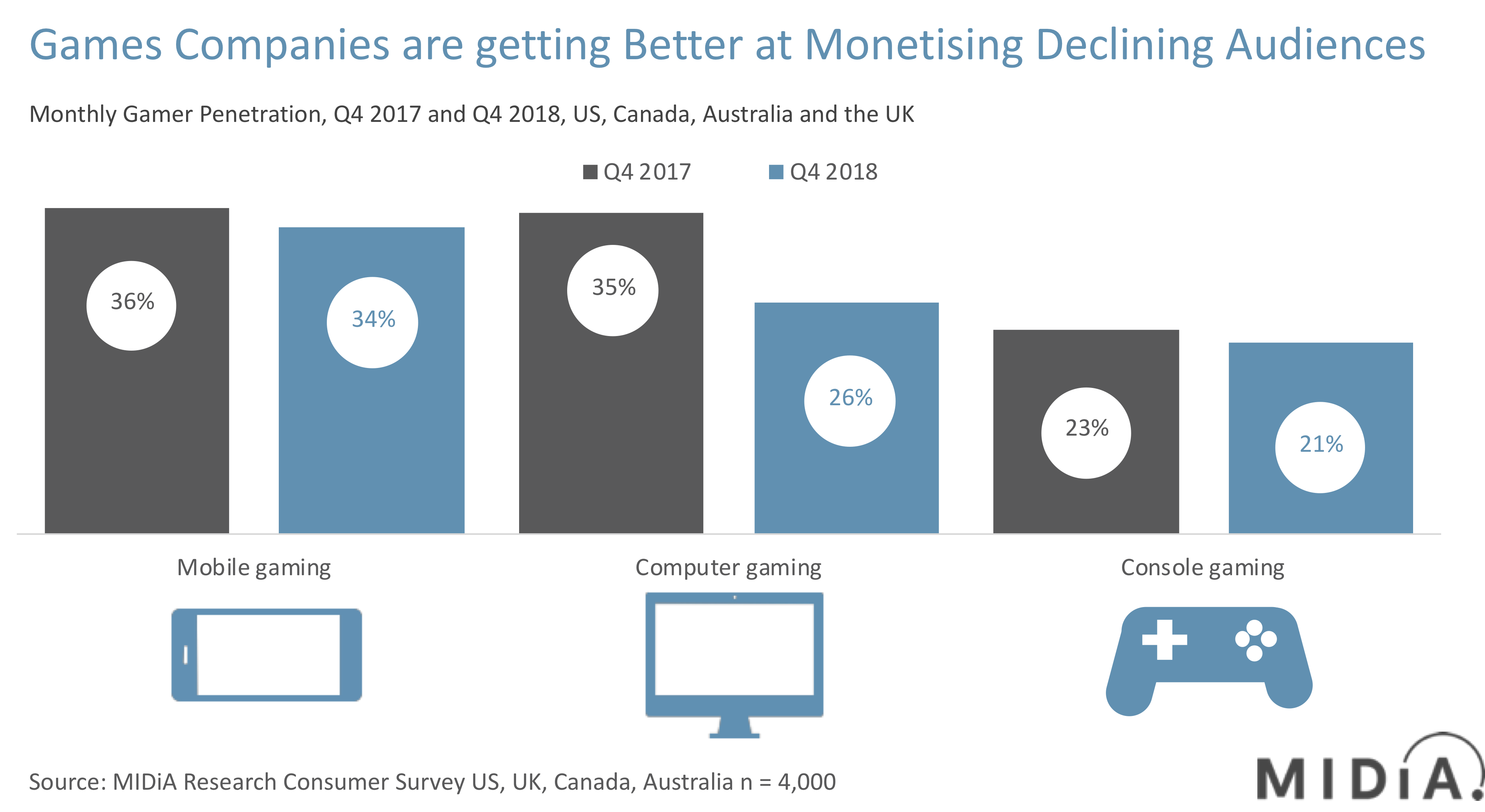Why Revenue Growth Alone Is Not Enough For The Games Industry


UK games revenues rose to $4.9 billion in 2018, surpassing music and video revenues combined. It is an impressive milestone, but it doesn't mean the best is yet to come. Revenues are what keep the lights on, but they are not always the best measure of the health of a sector. Instead, audience behaviour gives us the best sense of where markets are heading. And when we look at the direction of travel for games audiences, a very different picture emerges.
Data from MIDiA’s Quarterly Tracker survey for the US, Canada, Australia and the UK, suggests a secular decline of gaming audiences:
- Peak attention: Games has been the canary in the mine as the entertainment industries face peak in the attention economy. In the early days of mobile, before streaming services had come to the fore, consumers filled their dead time playing games like Angry Birds, Candy Crush Saga and Clash of Clans. But once Spotify, Netflix and co started pushing streaming into the mainstream, these newly-converted casual gamers switched back to pursuing their core interests. Instead of catapulting feathered creatures on the train ride to work, catching the latest episode of a Netflix original or listening to a new playlist became the norm.
- Competing with streaming: This impact of the peak attention has not however been limited to mobile. With far more TV and music being made than ever before, and better targeted at specific consumer segments and tastes, music and video are taking more available consumption time, even from gamers. This was well illustrated by the much-anticipated launch of Assassins Creed: Origins, which could have performed better, had it not coincided with the release of Netflix’s Stranger Things 2. According to MIDiA’s Tracker data, Assassin’s Creed fans were twice as likely as other consumers to also be Stranger Things fans. Gaming does not exist in the entertainment vacuum it once did. Overall, console gaming is probably the least volatile of the gaming audiences. Unless you have invested in a super high-end gaming PC, if you are a mobile or PC gamer, those devices are not dedicated gaming devices. This means they are much more vulnerable to gamers using those devices for other entertainment formats. Unsurprisingly, over the same period as these gaming audiences declined, music and video penetration rose.
- Competing with gamers: Alongside all this, gamer videos have risen strongly both on YouTube and on Twitch (>150 million MAUs). Fortnite streamer Ninja just announced that he earned $10 million in 2018, streaming a staggering 4,000 hours (there are a total 8,760 hours in a year, around 40% of which are meant for sleeping!). Watching gaming videos is a huge activity among Gen Zs and younger Millennials but it takes time away from gaming itself. Gaming as a spectator sport is competing with game playing just in the same way televised sports has been competing with actual participation in sports for decades now.
Pre-peak conditions
The games industry is not about to collapse, but a slowdown is likely around the corner. Before the music industry went into a tailspin at the start of the millennium, record label execs were hubristic, with an absolute confidence in the health of their business. So much so that they started taking their customers for granted, hiking up CD prices every year. We are in a similar situation with games now. Not only is there supreme confidence, but prices are being hiked too; in the UK the average price of games titles has increased by more than a fifth over the last decade.
What comes next?
To be clear, the games industry is still in rude health and there are countless new milestones that support this. For example, Red Redemption 2 was the biggest opening weekend IN THE HISTORY OF ENTERTAINMENT! (though this must be offset with the fact that most other media is moving away from sales and towards consumptions, so really these records are a contest between games and movies these days, not music and video). Meanwhile, Epic Game’s Fortnite phenomenon has more than 200 million monthly gamers. But the underlying audience shifts are inescapable. For now, the games industry is getting better at monetising its super fans — as illustrated by the 26% growth in Xbox Live MAUs in 2018), but unless it also starts building a ‘retain and win back’ strategy for the more casual end of its customer base, a slowdown could easily tip into a decline.


The discussion around this post has not yet got started, be the first to add an opinion.